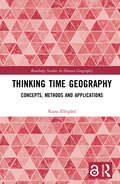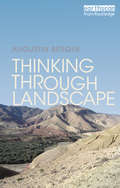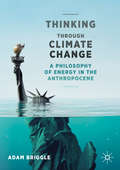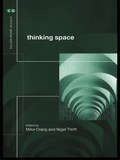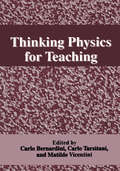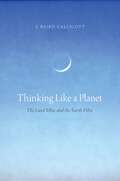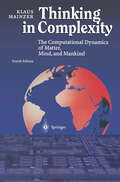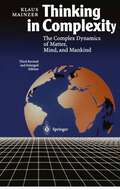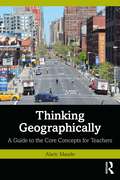- Table View
- List View
Third World Cities
by the late Drakakis-SmithThis imformative book is a thoroughly revised and updated edition of the classic introduction to urbanization in developing areas. Using case studies of cities drawn from around the world, including Bangkok, Delhi, Manila, Mexico City, Singapore and cities in Zimbabwe, this key text confronts three main questions: Is there still a Third World, does it have a common urban form, and what is the relationship between urbanization and sustainability? The text analyzes: the dimension of urban growth in the third world historical perspectives on urban growth urban population growth employment and incomes in the city basic needs and human rights environmental problems in third world cities planning and management of cities. Containing a wealth of student-friendly features including boxed case-studies, discussion questions and guides for further reading, this text provides an invaluable introduction to the issues and processes of the city in the Third World. Containing a greater depth of content and referencing, and with new chapters and subjects covered, this new second edition utilizes its larger format to make extensive use of illustrations, diagrams, global case studies, and further reading. Overall, these changes have contributed to this book's continuance as an extremely accessible student text.
Third Workshop on Grand Unification: University of North Carolina, Chapel Hill April 15–17, 1982 (Progress in Mathematical Physics #6)
by P.H. Frampton S.L. Glashow H. Van DamThis workshop held at the University of North Carolina was in the series which started with meetings in the University of New Hampshire (April 1980) and the University of Michigan (April 1981). More than one hundred participants congregated in the Carolina Inn in April 1982 to discuss the status of grand unified theories and their connection to experiment. The spring foliage of Chapel Hill provided a beautiful back-drop to this Third Workshop on Grand Unification. As mentioned in the first talk herein, these three workshops have heard of indications, respectively, of neutrino oscillations, proton decay and a magnetic monopole. Since all three experimental reports remain unconfirmed, grand unifiers must wait expectantly and patiently. These proceedings preserve faithfully the ordering of the workshop talks which followed the tradition of alternation between theory and experiment. Only our introduction will segregate them. The experimental presentations mainly concerned proton decay and massive neutrinos. Four U.S. proton decay experiments were reported: the Brookhaven Irvine-Michigan experiment in the Morton Salt Mine at Fairport Harbor, Ohio was described by WILLIAM KROPP, and ROBERT MORSE represented the Harvard-Purdue-Wisconsin group in the Silver King Mine, Utah. The Homestake Mine, South Dakota and Soudan Mine, Minnesota, experiments were reported respectively by RICHARD STEINBERG and DAVID AYRES, the latter providing also a survey of future U.S. experiments.
Third Millennium BC Climate Change and Old World Collapse (Nato ASI Subseries I: #49)
by H. Nüzhet Dalfes George Kukla Harvey WeissAround 4000 years ago the advanced urban civilizations in Egypt, Mesopotamia and India suddenly collapsed. What happened? Did a prolonged drought cause the breakdown of social order? Recent discoveries from all over the world strongly support the suspected link of the collapse with climate. The volume presents the findings of more than 40 researchers and provides a review on the relevant information. It appears that a major shift of the precipitation pattern affected many parts of the world at approximately the same time, with disastrous effects on the nomadic populations of Asia, Africa and Eastern Europe. Can a similar climate shift with a serious adverse impact on society happen again? In a world facing global warming, there could be many lessons to be learned from the experiences of ancient societies.
Thinking Time Geography: Concepts, Methods and Applications (Routledge Studies in Human Geography)
by Kajsa EllegårdTime-geography is a mode of thinking that helps in the understanding of change in society, the wider context and ecological consequences of human actions. This book presents its assumptions, concepts and methods, and example applications. The intellectual path of the Swedish geographer Torsten Hägerstrand is a key foundation for this book. His research contributions are shown in the context of the urbanization of Sweden, involvement in the emerging planning sector and empirical studies on Swedish emigration. Migration and innovation diffusion studies paved the way for prioritizing time and space dimensions and recognizing time and space as unity. From these insights time-geography grew. This book includes the ontological grounds and concepts as well as the specific notation system of time-geography – a visual language for interdisciplinary research and communication. Applications are divided into themes: urban and regional planning; transportation and communication; organization of production and work; everyday life, wellbeing and household division of labor; and ecological sustainability – time-geographic studies on resource use. This book looks at the outlook for this developing branch of research and the future application of time-geography to societal and academic contexts. Its interdisciplinary nature will be appealing to postgraduates and researchers who are interested in human geography, urban and regional planning and sociology.
Thinking Time Geography: Concepts, Methods and Applications (Routledge Studies in Human Geography)
by Kajsa EllegårdTime-geography is a mode of thinking that helps in the understanding of change in society, the wider context and ecological consequences of human actions. This book presents its assumptions, concepts and methods, and example applications. The intellectual path of the Swedish geographer Torsten Hägerstrand is a key foundation for this book. His research contributions are shown in the context of the urbanization of Sweden, involvement in the emerging planning sector and empirical studies on Swedish emigration. Migration and innovation diffusion studies paved the way for prioritizing time and space dimensions and recognizing time and space as unity. From these insights time-geography grew. This book includes the ontological grounds and concepts as well as the specific notation system of time-geography – a visual language for interdisciplinary research and communication. Applications are divided into themes: urban and regional planning; transportation and communication; organization of production and work; everyday life, wellbeing and household division of labor; and ecological sustainability – time-geographic studies on resource use. This book looks at the outlook for this developing branch of research and the future application of time-geography to societal and academic contexts. Its interdisciplinary nature will be appealing to postgraduates and researchers who are interested in human geography, urban and regional planning and sociology.
Thinking Through the Environment: A Reader
by Mark J. SmithThis reader brings together material from ecological thought, environmental policy, environmental philosophy, social and political thought, historical sociology and cultural studies. The extracts tell the story of the way the natural environment has been understood in the modern world and how this has recently been questioned as contemporary societies are seen as characterised by uncertainty and complexity.The literature guides the reader through the conventiaonal grounds for thinking about rights and obligations in relation to future generations, non-human animals and the biotic commununities, bringing each into question. This then leads into a critical examination of social and political theories and their capacity for drawing on ecological thought. Each of the seven sections of readings is introduced by the editor who locates the set of readings within the specific themes and issues at the heart of each section.This broad-reaching and thought-provoking set of readings stresses the diversity of response to environmental problems both within and between anthropocentric and ecocentric approaches and will encourage the reader to examine how they are manifested in the areas of environmental ethics, policy analysis and social and political theory.
Thinking Through the Environment: A Reader
by Mark J. SmithThis reader brings together material from ecological thought, environmental policy, environmental philosophy, social and political thought, historical sociology and cultural studies. The extracts tell the story of the way the natural environment has been understood in the modern world and how this has recently been questioned as contemporary societies are seen as characterised by uncertainty and complexity.The literature guides the reader through the conventiaonal grounds for thinking about rights and obligations in relation to future generations, non-human animals and the biotic commununities, bringing each into question. This then leads into a critical examination of social and political theories and their capacity for drawing on ecological thought. Each of the seven sections of readings is introduced by the editor who locates the set of readings within the specific themes and issues at the heart of each section.This broad-reaching and thought-provoking set of readings stresses the diversity of response to environmental problems both within and between anthropocentric and ecocentric approaches and will encourage the reader to examine how they are manifested in the areas of environmental ethics, policy analysis and social and political theory.
Thinking through Landscape
by Augustin BerqueOur attitude to nature has changed over time. This book explores the historical, literary and philosophical origins of the changes in our attitude to nature that allowed environmental catastrophes to happen.The book presents a philosophical reflection on human societies’ attitude to the environment, informed by the history of the concept of landscape and the role played by the concept of nature in the human imagination. It features a wealth of examples from around the world to help understand the contemporary environmental crisis in the context of both the built and natural environment. Berque locates the start of this change in human labour and urban elites being cut off from nature. Nature became an imaginary construct masking our real interaction with the natural world. He argues that this gave rise to a theoretical and literary appreciation of landscape at the expense of an effective practical engagement with nature. This mindset is a general feature of the world's civilizations, manifested in similar ways in different cultures across Europe, China, North Africa and Australia. Yet this approach did not have disastrous consequences until the advent of western industrialization.As a phenomenological hermeneutics of human societies’ environmental relation to nature, the book draws on Heideggerian ontology and Veblen’s sociology. It provides a powerful distinction between two attitudes to landscape: the tacit knowledge of earlier peoples engaged in creating the landscape through their work - “landscaping thought”- and the explicit theoretical and aesthetic attitudes of modern city dwellers who love nature while belonging to a civilization that destroys the landscape - “landscape thinking”. This book gives a critical survey of landscape thought and theory for students, researchers and anyone interested in human societies’ relation to nature in the fields of landscape studies, environmental philosophy, cultural geography and environmental history.
Thinking through Landscape
by Augustin BerqueOur attitude to nature has changed over time. This book explores the historical, literary and philosophical origins of the changes in our attitude to nature that allowed environmental catastrophes to happen.The book presents a philosophical reflection on human societies’ attitude to the environment, informed by the history of the concept of landscape and the role played by the concept of nature in the human imagination. It features a wealth of examples from around the world to help understand the contemporary environmental crisis in the context of both the built and natural environment. Berque locates the start of this change in human labour and urban elites being cut off from nature. Nature became an imaginary construct masking our real interaction with the natural world. He argues that this gave rise to a theoretical and literary appreciation of landscape at the expense of an effective practical engagement with nature. This mindset is a general feature of the world's civilizations, manifested in similar ways in different cultures across Europe, China, North Africa and Australia. Yet this approach did not have disastrous consequences until the advent of western industrialization.As a phenomenological hermeneutics of human societies’ environmental relation to nature, the book draws on Heideggerian ontology and Veblen’s sociology. It provides a powerful distinction between two attitudes to landscape: the tacit knowledge of earlier peoples engaged in creating the landscape through their work - “landscaping thought”- and the explicit theoretical and aesthetic attitudes of modern city dwellers who love nature while belonging to a civilization that destroys the landscape - “landscape thinking”. This book gives a critical survey of landscape thought and theory for students, researchers and anyone interested in human societies’ relation to nature in the fields of landscape studies, environmental philosophy, cultural geography and environmental history.
Thinking Through Climate Change: A Philosophy of Energy in the Anthropocene (Palgrave Studies in the Future of Humanity and its Successors)
by Adam BriggleIn this creative exploration of climate change and the big questions confronting our high-energy civilization, Adam Briggle connects the history of philosophy with current events to shed light on the Anthropocene (the age of humanity). Briggle offers a framework to help us understand the many perspectives and policies on climate change. He does so through the idea that energy is a paradox: changing sameness. From this perennial philosophical mystery, he argues that a high-energy civilization is bound to create more and more paradoxes. These paradoxes run like fissures through our orthodox picture of energy as the capacity to do work and control fate. Climate change is the accumulation of these fissures and the question is whether we can sustain technoscientific control and economic growth. It may be that our world is about change radically, imploring us to start thinking heterodox thoughts.
Thinking Space (Critical Geographies Ser. #Vol. 9)
by Mike Crang Nigel ThriftAs theorists have begun using geographical concepts and metaphors to think about the complex and differentiated world, it is important to reflect on their work, and its impact on our thoughts on space. This revealing book explores the work of a wide range of prolific social theorists. Included contributions from an impressive range of renowned geographical writers, each examine the work of one writer - ranging from early this century to contemporary writers. Among the writers discussed are Georg Simmel, Mikhail Bakhtin, Gilles Deleuze, Helene Cixous, Henri Lefebvre, Jacques Lacan, Pierre Bourdieu, Michel Foucault and Franz Fanon. Ideal for those interested in the 'spatial turn' in social and cultural theory, this fascinating book asks what role space plays in the work of such theorists, what difference (if any) it makes to their concepts, and what difference such an appreciation makes to the way we might think about space.
Thinking Space (Critical Geographies Ser. #Vol. 9)
by Mike Crang Nigel ThriftAs theorists have begun using geographical concepts and metaphors to think about the complex and differentiated world, it is important to reflect on their work, and its impact on our thoughts on space. This revealing book explores the work of a wide range of prolific social theorists. Included contributions from an impressive range of renowned geographical writers, each examine the work of one writer - ranging from early this century to contemporary writers. Among the writers discussed are Georg Simmel, Mikhail Bakhtin, Gilles Deleuze, Helene Cixous, Henri Lefebvre, Jacques Lacan, Pierre Bourdieu, Michel Foucault and Franz Fanon. Ideal for those interested in the 'spatial turn' in social and cultural theory, this fascinating book asks what role space plays in the work of such theorists, what difference (if any) it makes to their concepts, and what difference such an appreciation makes to the way we might think about space.
Thinking Space (Critical Geographies)
by Mike Crang Nigel ThriftAs theorists have begun using geographical concepts and metaphors to think about the complex and differentiated world, it is important to reflect on their work, and its impact on our thoughts on space. This revealing book explores the work of a wide range of prolific social theorists. Included contributions from an impressive range of renowned geographical writers, each examine the work of one writer - ranging from early this century to contemporary writers. Among the writers discussed are Georg Simmel, Mikhail Bakhtin, Gilles Deleuze, Helene Cixous, Henri Lefebvre, Jacques Lacan, Pierre Bourdieu, Michel Foucault and Franz Fanon. Ideal for those interested in the 'spatial turn' in social and cultural theory, this fascinating book asks what role space plays in the work of such theorists, what difference (if any) it makes to their concepts, and what difference such an appreciation makes to the way we might think about space.
Thinking Space (Critical Geographies)
by Mike Crang Nigel ThriftAs theorists have begun using geographical concepts and metaphors to think about the complex and differentiated world, it is important to reflect on their work, and its impact on our thoughts on space. This revealing book explores the work of a wide range of prolific social theorists. Included contributions from an impressive range of renowned geographical writers, each examine the work of one writer - ranging from early this century to contemporary writers. Among the writers discussed are Georg Simmel, Mikhail Bakhtin, Gilles Deleuze, Helene Cixous, Henri Lefebvre, Jacques Lacan, Pierre Bourdieu, Michel Foucault and Franz Fanon. Ideal for those interested in the 'spatial turn' in social and cultural theory, this fascinating book asks what role space plays in the work of such theorists, what difference (if any) it makes to their concepts, and what difference such an appreciation makes to the way we might think about space.
Thinking Russia's History Environmentally (Environment in History: International Perspectives #25)
by Catherine Evtuhov, Julia Lajus, and David MoonHistorians of Russia were relative latecomers to the field of environmental history. Yet, in the past decade, the exploration of Russian environmental history has burgeoned. Thinking Russia’s History Environmentally showcases collaboration amongst an international set of scholars who focus on the contribution that the study of Russian environments makes to the global environmental field. Through discerning analysis of natural resources, the environment as a factor in historical processes such as industrialization, and more recent human-animal interactions, this volume challenges stereotypes of Russian history and in so doing, highlights the unexpected importance of Russian environments across a time frame well beyond the ecological catastrophes of the Soviet period.
Thinking Russia's History Environmentally (Environment in History: International Perspectives #25)
by Catherine Evtuhov Julia Lajus David MoonHistorians of Russia were relative latecomers to the field of environmental history. Yet, in the past decade, the exploration of Russian environmental history has burgeoned. Thinking Russia’s History Environmentally showcases collaboration amongst an international set of scholars who focus on the contribution that the study of Russian environments makes to the global environmental field. Through discerning analysis of natural resources, the environment as a factor in historical processes such as industrialization, and more recent human-animal interactions, this volume challenges stereotypes of Russian history and in so doing, highlights the unexpected importance of Russian environments across a time frame well beyond the ecological catastrophes of the Soviet period.
Thinking Physics for Teaching
by C. Bernardini C. Tarsitani M. VicentiniThe research in Physics Education has to do with the search of solutions to the complex problem of how to improve the learning and teaching of physics. The complexity of the problem lies in the different fields of knowledge that need to be considered in the research. In fact, besides the disciplinary knowledge in physics (which must be considered from the conceptual, the historical, and the epistemological framework), one has to take into account some basic knowledge in the context of psychology and the cognitive sciences (for the general and contextual aspects of learning) and some basic knowledge in education and comunication (for what concerns teaching skills and strategies). Looking back at the historical development of the research one may recognize that the complexity of the endeavour was not clear at first but became clear in its development, which shifted the focus of the research in the course of time from physics to learning to teaching. We may say that the research started, more than 30 years ago, with a focus on disciplinary knowledge. Physicists in different parts of the western world, after research work in some field of physics, decided to concentrate on the didactical comunication of physical knowledge.
Thinking Like a Planet: The Land Ethic and the Earth Ethic
by J. Baird CallicottBringing together ecology, evolutionary moral psychology, and environmental ethics, J. Baird Callicott counters the narrative of blame and despair that prevails in contemporary discussions of climate ethics and offers a fresh, more optimistic approach. Whereas other environmental ethicists limit themselves to what Callicott calls Rational Individualism in discussing the problem of climate change only to conclude that, essentially, there is little hope that anything will be done in the face of its "perfect moral storm" (in Stephen Gardiner's words), Callicott refuses to accept this view. Instead, he encourages us to look to the Earth itself, and consider the crisis on grander spatial and temporal scales, as we have failed to in the past. Callicott supports this theory by exploring and enhancing Aldo Leopold's faint sketch of an Earth ethic in "Some Fundamentals of Conservation in the Southwest," a seldom-studied text from the early days of environmental ethics that was written in 1923 but not published until 1979 after the environmental movement gathered strength.
Thinking in Physics: The pleasure of reasoning and understanding
by Laurence ViennotRead this book if you care about students really understanding physics and getting genuine intellectual satisfaction from doing so. Read it too if you fear that this goal is out of reach – you may be surprised! Laurence Viennot here shows ways to deal with the awkward fact that common sense thinking is often not the same as scientific thinking. She analyses examples of frequent and widespread errors and confusions, which provide a real eye-opener for the teacher. More than that, she shows ways to avoid and overcome them. The book argues against over-emphasis on “fun” applications, demonstrating that students also enjoy and value clear thinking.The book has three parts: • making sense of special scientific ways of reasoning (words, images, functions)• making connections between very different topics, each illuminating the other• simplifying, looking for consistency and avoiding incoherent over-simplificationThe book is enhanced with supplementary online materials that will allow readers to further expand their teaching or research interests and think about them more deeply.
Thinking in Complexity: The Computational Dynamics of Matter, Mind, and Mankind
by Klaus MainzerThis new edition also treats smart materials and artificial life. A new chapter on information and computational dynamics takes up many recent discussions in the community.
Thinking in Complexity: The Complex Dynamics of Matter, Mind, and Mankind
by Klaus MainzerSince the first edition sold out in less than a year, we now present the revised second edition of Mainzer's popular book. The theory of nonlinear complex systems has become a successful problem-solving approach in the natural sciences from laser physics, quantum chaos, and meteorology to computer simulations of cell growth in biology. It is now recognized that many of our social, ecological, and political problems are also of a global, complex, and nonlinear nature. And one of the most exciting contemporary topics is the idea that even the human mind is governed largely by the nonlinear dynamics of complex systems. In this wide-ranging but concise treatment, Prof. Mainzer discusses, in a nontechnical language, the common framework behind these endeavors. Emphasis is given to the evolution of new structures in natural and cultural systems and we see clearly how the new integrative approach can give insights not available from traditional reductionistic methods.
Thinking in Complexity: The Complex Dynamics of Matter, Mind, and Mankind
by Klaus MainzerComplexity and nonlinearity are prominent features in the evolution of matter, life, and human society. Even our mind seems to be governed by the nonlinear dynamics of the complex networks in our brain. This book considers complex systems in the physical and biological sciences, cognitive and computer sciences, social and economic sciences, and philosophy and history of science. An in terdisciplinary methodology is introduced to explain the emergence of order in nature and mind and in the econ omy and society by common principles. These methods are sometimes said to foreshadow the new sciences of complexity characterizing the scientific deve10pment of the 21 st century. The book critically an alyzes the successes and limits of this approach, its sys tematic foundations, and its historical and philosophical background. An epilogue discusses new standards of eth ical behavior which are demanded by the complex prob lems of nature and mind, economy and society.
Thinking in Complexity: The Complex Dynamics of Matter, Mind, and Mankind
by Klaus MainzerThis new edition also treats smart materials and artificial life. A new chapter on information and computational dynamics takes up many recent discussions in the community.
Thinking Geographically: A Guide to the Core Concepts for Teachers
by Alaric MaudeThis book explains how the concepts of geography can teach young people to think geographically, deeply and ethically. Thinking Geographically demonstrates how the concepts of place, space, environment and interconnection teach students new ways of perceiving and understanding the world, the concepts of scale and time teach them ways of analysing the world, while the concepts of sustainability and wellbeing show them how to evaluate and reflect on what they observe, and all eight concepts develop their higher order and critical thinking. To further support teachers, this book includes a chapter on how to teach for conceptual understanding, as well as two chapters that illustrate the application of geographical thinking to an understanding of the effects of land cover change and the problem of regional inequality. Rich with practical examples, this book is an essential resource for geography teachers, whether already teaching or studying to become one, and for those who teach therm.




